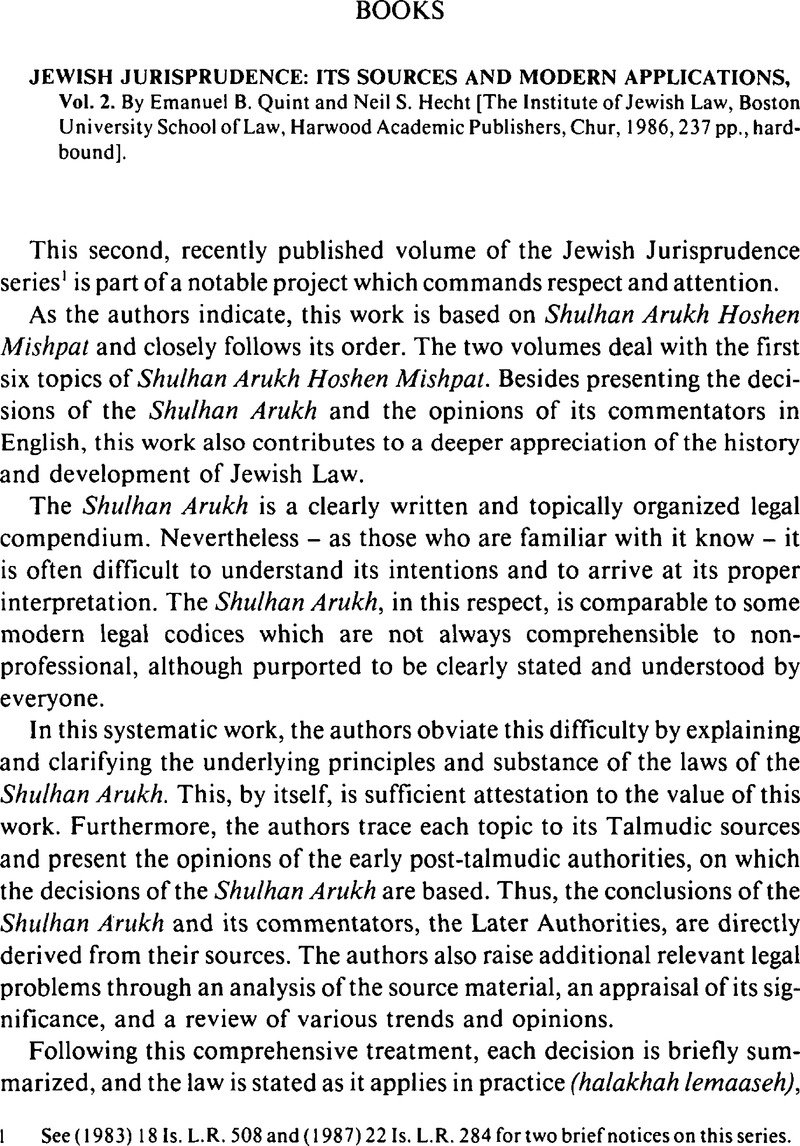No CrossRef data available.
Published online by Cambridge University Press: 16 February 2016

1 See (1983) 18 Is.L.R. 508Google Scholar and (1987) 22 Is. L.R. 284Google Scholar for two brief notices on this series.
2 Literally – “The Manner in Which a Person may Adjudicate for Himself”: Sec. 4 in Shulhan Arukh; Vol. 2, chap. 4, in the book under review.
3 Maimonides in his Code follows the same practice by including self-help in The Laws of Sanhedrin 22:12Google Scholar, which deals with the appointment of judges. Apparently R. Jacob b. Asher, the author of Tur, was influenced by this and included self-help in the Laws of Judges. R. Joseph Karo in the Shulhan Arukh followed the same order.
4 Cf. Tur, Hoshen Mishpal, 4, and certainly one must not judge his own case.
5 Cf. Englard, I., “Dine Nezikin”, in The Law of Civil Wrongs: The General Part, Tedeschi, G., ed. (Jerusalem, 2nd ed., 1976, in Hebrew) 533–34Google Scholar.
6 Baba Bathra 34b; Maimonides, , Laws of Pleading. 15:4Google Scholar.
7 Baba Kama 16b.
8 Talmudic Encyclopedia. Vol. VII. “dinei shamayim”.
9 Prescription Law, 1958 (12 L.S.I. 129).
10 It is likely that this ruling is unanimous. For instance, R. Aha of Sabha (Sheiltolh Bereshith: Sheiltah 2), rules that a man may not use force against another with whom he is in litigation. In my opinion, this is not a legal ruling or a decision of the Amoraic debate. It is said, rather, on the ethical level, of “acting beyond the call of law”.
11 Baba Mezia 9:13Google Scholar.
12 Deut. 24:10–13.
13 1:16, based on Baba Kama 48a.
14 The Laws Concerning Slaves 3:5Google Scholar.
15 Cf. Tur, Hoshen Mishpat, 421.
16 See Falk, Ze'ev, Legal Values and Judaism (Jerusalem, 1981, in Hebrew) 14 and 67Google Scholar.
17 There are many examples of this, although it must be pointed out that individual rights do not always supersede public interests.
18 We would also like to draw the readers' attention to section 6 of this chapter (p. 135ff) which treats the question of “Self-help where a community is a party”. This is an interesting and important topic which has not yet been researched in depth, and the authors' contribution is of special significance.